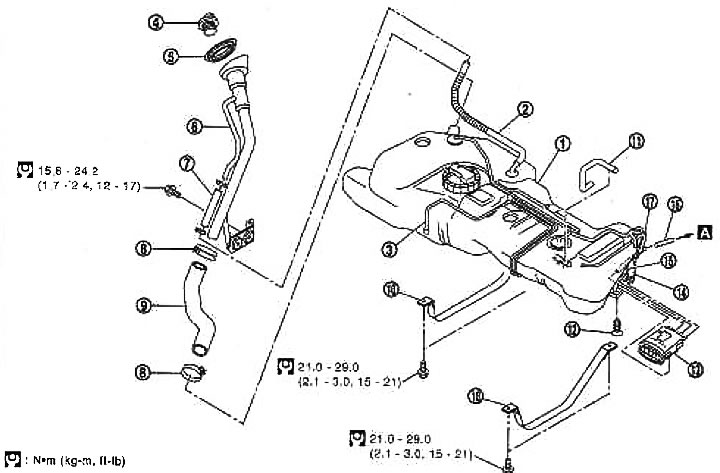
1. Fuel tank; 2. Ventilation hose; 3. EVAP tube; 4. Fuel filler cap; 5. Rubber bushing; 6. Filler pipe; 7. Ventilation hose; 8. Clamp; 9. Filler hose; 10. Tape collar of the fuel tank; 12. EVAP hose; 13. EVAP carbon filter fixing screw; 14. EVAP* carbon filter hose; 15. Hose filter EVAP**; 16. EVAP inlet; 17. EVAP inlet
*: To fuel tank
**: To EVAP charcoal filter purge solenoid valve
A: Air inlet
Removing
Attention: When working on the fuel system, read «General Precautions».
1. Remove the rear right wheel.
2. Follow steps. 1-7 sections «Fuel level sensor, fuel filter and fuel pump assembly», P. «Withdrawal».
Attention: If the fuel tank is not level and there is a lot of fuel in it, its position becomes unstable and creates a hazard. Drain more fuel than indicated in paragraph 1 of the section referenced above so that the fuel tank can be held by hand in case of loss of balance.
3. Remove the central and main silencers. See section «Exhaust system».
4. Remove an insulator from the car on a site of the central and main mufflers.
5. Move the parking brake cable away from the bottom of the fuel tank. Then remove the clips securing the parking brake cable.
6. Disconnect the filler hose from the fuel tank side.

Attention: Do not disconnect the filler hose from the side of the filler tube, so that during installation it does not interfere with the suspension due to displacement. If it is necessary to disconnect from the side of the filler tube, mark the alignment and disconnect.
7. Disconnect the ventilation hose from the side of the rear right wheel well.
8. Disconnect the EVAP hose from the front of the fuel tank.
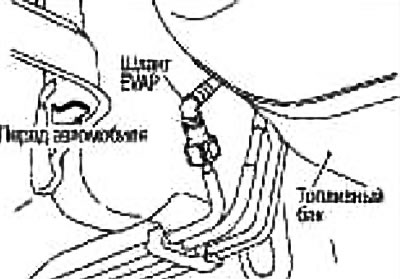
Disconnect the quick fitting as follows:
- Grasp the fitting on both sides, press in the latches and remove the fuel tube.
- If the nipple is stuck to the tube of the transmitter unit, move them back and forth a few times until they come free. Then disconnect them by pulling in different directions.
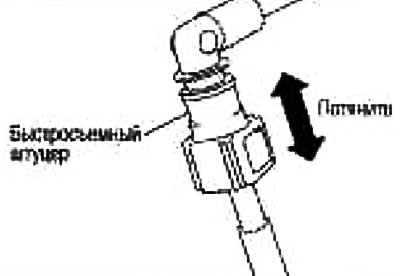
Attention:
- The tube can be detached when the latches are fully recessed. Do not twist it more than necessary.
- Do not disconnect the quick fitting with any tool.
- Protect the plastic tube from heat. Especially when carrying out welding work near the tube.
- Do not allow acid-containing liquids, such as battery electrolyte, etc., to come into contact with the plastic tube.
- Do not bend or twist the plastic tube when connecting or disconnecting.
To keep the connection area clean and to prevent damage and foreign matter, completely cover it with plastic bags, etc.
Caution: To avoid damaging the O-ring, do not insert plugs in the quick fitting.
9. If necessary, unscrew the mounting screw, disconnect the quick-release fittings and slide the EVAP carbon filter back and remove from the fuel tank.
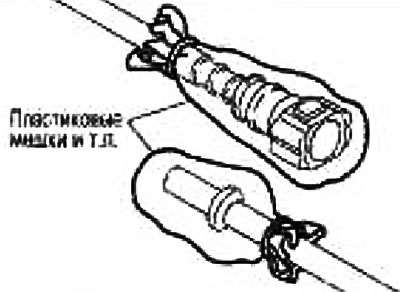
Note: For servicing the evaporative emission system components, see chapter Engine management system.
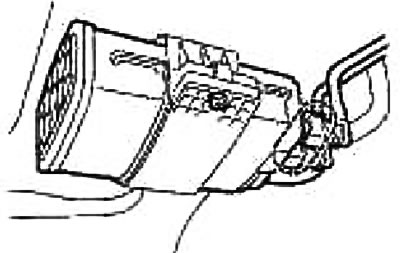
10. Support the center of the fuel tank with a telescoping stand.
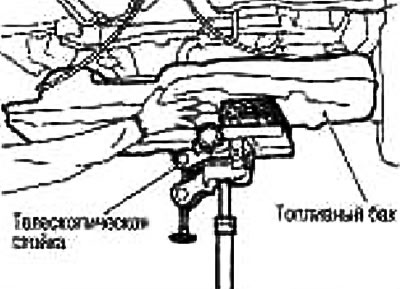
Caution: Place a piece of wood between the telescopic pole and the fuel tank.
11. Remove the fuel tank band clamps on the right and left.
12. While supporting the fuel tank with your hands, carefully lower the telescoping stand and remove the tank. Do the following at the same time:
Disconnect the vent. hose through a through hole in the car.
Pull back the parking brake cable by hand so that it does not hit the fuel tank.
Caution: The fuel tank may be in an unstable position due to the shape of its bottom. Do not rely on the telescopic stand. Support the tank securely with your hands.
Installation
Installation is carried out in the reverse order of removal, taking into account the following:
Installing band clamps
Install them according to the markings «R» (right) And «L» (left), embossed on the ends.
Installing the filler hose
Install the fuel filler hose on the fuel tank with the marking facing down.
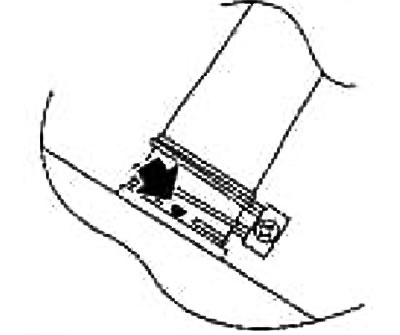
Attach the filler hose (2) on the filler tube (1) labeled down.
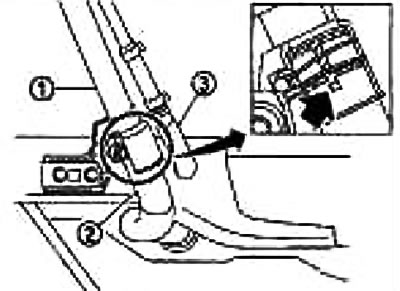
Push the hose onto the tube to a depth of 35 mm and secure with a clamp.
Make sure the hose clamp is not stuck on the thickened part (bead) fuel pipe.
Tighten the fuel hose clamp so that the distance from the end of the hose is 5-9 mm [tightening torque: 1.3-3.7 Nm (0.13-0.38 kg m)].
Installing the EVAP Hose
Connect the quick fitting as follows:
1. Check the joints for damage and foreign particles.
2. Center the fitting with the hose, then insert the fitting at a right angle until it clicks into place.
3. After connecting, make sure the connection is secure by pulling.
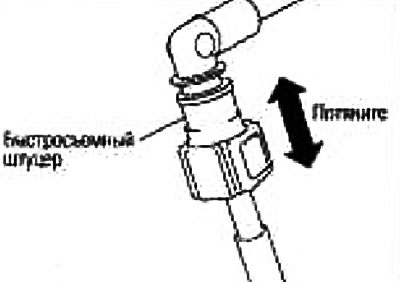
Check after installation
Check for fuel leaks by doing the following:
1. Turn the ignition key to position «ON» (without starting the engine). After pressurizing the fuel lines, check for fuel leaks at the joints.
2. Start the engine. While increasing the engine speed, check again for fuel leaks at the fuel line joints.